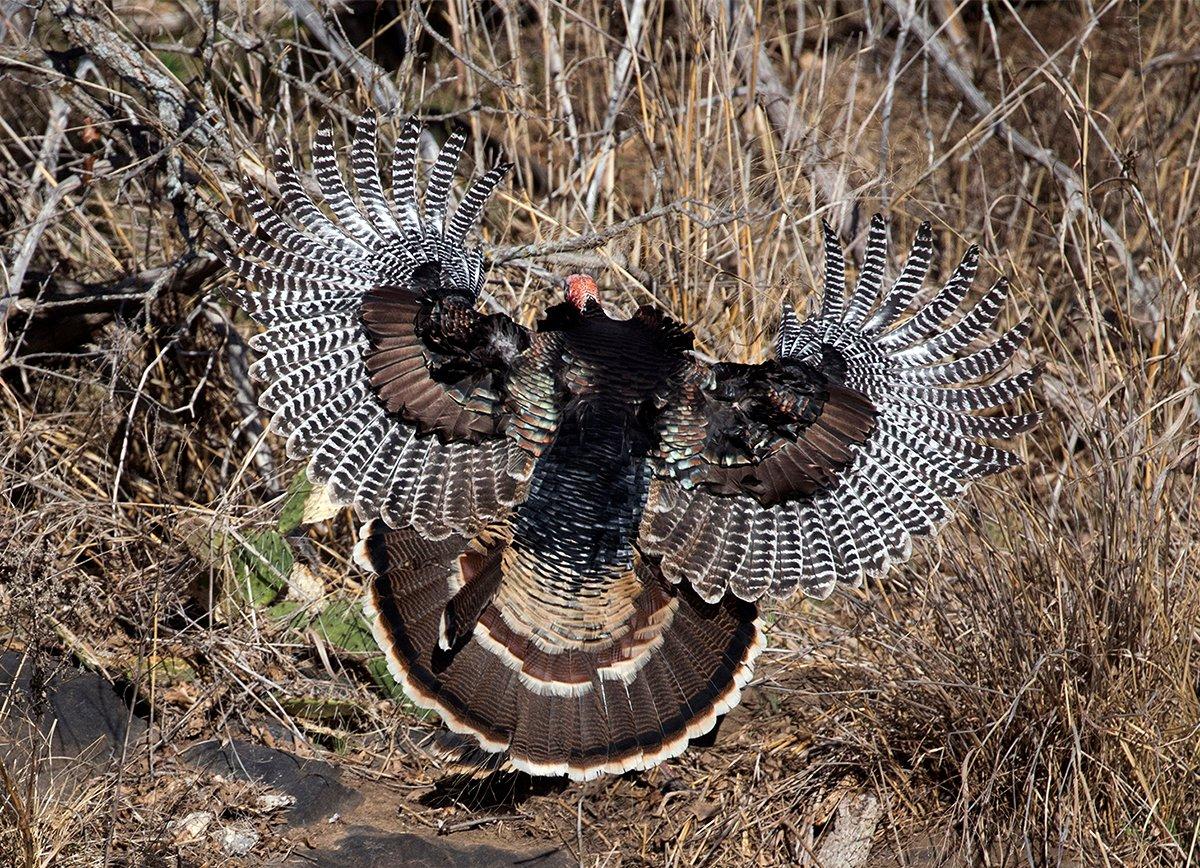Yep, most of the time, it’s best to get a wild turkey into range, and squeeze off a shot dialed-in on the standing bird’s head and neck. Most of the time we do that. Some of the time we don’t. This is for those times.
You shot. The bird flopped a bit, then got up like a boxer in the ring with some fight left in him, and is running like a racehorse, or worse, flying off into the blue patch of sky rising up above the wooded timber. You curse. You can’t believe it, but the self-pity can wait …
And now you need to shoot again. Though it’s not the best way to anchor a spring gobbler, there are situations when taking a turkey on the run or wing are the only options, especially after blown chances, or worse yet, when that bird is wounded.
Some ways to do it right follow. It’s your move, now or never.
1. If the Turkey is Flopping Off
Hustle if you can to the downed but flopping bird. There’s really nothing pretty about what you need to do next …
Your first shot was sloppy for whatever reason: poor form, hurrying your aim, bad choke and shotgun combo, whatever. Or your shot pellets scattered everywhere but the turkey’s head and neck.
Yep, I’ve been there. Safety on, I’ve hurried up on flopping birds with their heads up and bodies down. The key here is to click your safety off and calmly shoot the gobbler in the head and neck again.
But what if it’s flopping and covering ground? Well, then you have another problem.
You can lead the bird’s head as you would a running rabbit. That sometimes drops the turkey in its tracks. Or gun safety on, you can hipetty-hop like an overgrown bunny and awkwardly try to cover enough ground to shoot it again.
And if that doesn’t work, yes, I’ve put my shotgun down, taken off as if I were back in my track-and-field days … and tackled a longbeard (or two). Well, maybe more than two if you count the birds I’ve guided hunters to over the years.
You’ve got to do what it takes. But be careful friends, as those spurs can score some damage.
2. If the Turkey is Running
When a gobbler is running, you’ve got just seconds to deliver the payload.
Chances are you’re still sitting if you’ve called a gobbler into range. If the bird is legging it away, first maneuver your body for stability the best you can to make that next shot. Shoot while sitting, likely leaning forward, or …
If you’ve time – and you really only have a second or two – stand up. Ideally, your legs aren’t asleep or cramped, but there’s a chance that’s the case. As always, stay safe. Mount your gun quickly but smoothly. Cheek to stock. And shoot the crippled bird as it runs.
Once positioned, as with the flopping turkey just mentioned, shoot that flushing bird’s head and neck as you might a bounding rabbit.
Plant your left foot forward if you’re right-handed and vice-versa if you’re a southpaw. Snap shoot or swing through, depending on the angle and distance to the sprinting turkey.
Again, always try to find the neck and head in your sight picture – better yet, the wild black eye – and hit your intended target with a steady action.
And yep, a shotgun with an elaborate sighting system will always make this tougher, but it can be done. Open sights are much easier, but it’s hard to plan for a miss. Either way, aim at that running bird and shoot when it speeds into your sight picture.
3. If the Turkey is Flying
Right-handed wingshooters often hold their left index finger along the shotgun’s forend to point at the target as they shoulder the firearm. (Southpaws obviously reverse this.)
Practice this when shooting sporting clays, or other flying upland birds or waterfowl, and you’ll be ready (maybe) if the need presents itself while turkey hunting.
Then again, in the moment of truth, a sudden miss is a sudden mega-ton blast of regret and an immediate call to action. It’s hard to calm down in a split-second but you need to do it. Like now.
Upland bird and waterfowl shooters can rely on muscle memory to close the deal. Then again, sometimes it pays to hold back and eyeball the bird in the air, listening to hear if (and where) it falls from the sky.
4. Give It a Rest
Take a break. Scuff the dirt with a boot if you have to. Curse yourself again.
But, as with an arrowed deer, it surely pays to sit a bit and let the turkey stop running or flying off. That’s sometimes even true for shotgun misses, too. And if you’ve arrowed the bird, you may indeed find something of a blood trail to follow. Sometimes even with a gun shot. But don’t count on it.
Yep, there’s still hope after everything has settled down a bit.
Once you’ve given the bird some time to hide, and/or stop flopping, running or flying and finally die, apply these five ways to find a wounded turkey. And with luck and perseverance, you’ll get your hands on that gobbler and make your world good again – yet another follow-up shot or not.
More Realtree turkey hunting.













